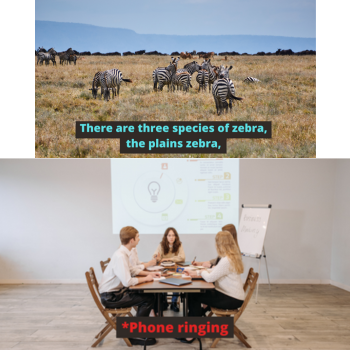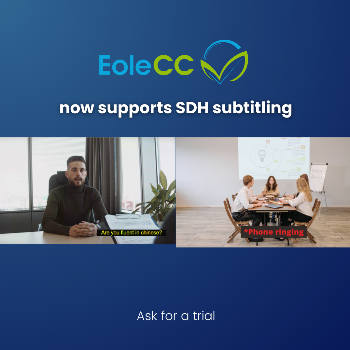IBC 2025 | Meet us in Amsterdam from 12 to15 september 2025

Understanding the Difference between SDH and CC in Subtitling
3 november 2023
In the realm of video production and accessibility, subtitling has emerged as an indispensable tool, bridging the gap between content and diverse audiences.
Subtitles allow viewers to comprehend audiovisual content despite language barriers or hearing impairments, ultimately enhancing the overall viewing experience.
In France, almost 1.7 million people are blind or partially sighted, and almost 5.4 million are deaf or hard of hearing, according to Surdi Info Service and the Fédération des aveugles et amblyopes de France. On a worldwide scale, 5% of the world population, ie 430 million, are Deaf or Hard of Hearing , according to the World Health Organization.
Two widely adopted subtitling techniques, Subtitles for the Deaf and Hard of Hearing (SDH) and Closed Captions (CC), play a pivotal role in ensuring inclusive and accessible content.
This article aims to shed light on the difference between SDH and CC, explore their unique features, and highlight several subtitling tools that video professionals can utilize to optimize their subtitling process.
Part 1: Understanding SDH
SDH, also known as Closed Captions for the Deaf or Hard of Hearing (CCDH), is a specialized form of subtitling designed to accommodate individuals who are deaf or have varying degrees of hearing loss.
These subtitles not only provide a transcription of the spoken dialogue but also include additional information that helps deaf and hard-of-hearing viewers better understand the audio content.
Such supplementary information may encompass : - non-verbal sounds (e.g., [applause], [thunder]), - speaker identification (e.g., [Interviewer], [Narrator]), - ndications of music or sound effects (e.g., [music playing], [door creaking]).
By including these cues, SDH ensures a more immersive experience for those with hearing impairments.
Sed ut tum
Key features of SDH
1. Full Dialogue Transcription: SDH encompasses a complete transcription of the dialogue, capturing all spoken words in the video to maintain informational integrity.
2. Additional Contextual Information: Beyond dialogue, SDH provides contextual details about sound effects, music, and speakers, enriching the viewing experience.
3. Speaker Identification: When multiple speakers are present, SDH clearly identifies each speaker, avoiding ambiguity.
4. On-Screen Placement: SDH subtitles are strategically placed on the screen, avoiding overlap with essential visuals and ensuring readability. Examples of elements to avoid: contrasts, animated text, etc
Part 2: Understanding CC
What are Closed Captions (CC)?
Closed Captions, commonly referred to as CC, are textual representations of audio content in videos that aid viewers in understanding dialogue and relevant audio elements.
Unlike SDH, CC primarily focus on transcribing the spoken dialogue without additional information about sound effects or speaker identification. While designed for accessibility, CC caters to a broader audience, including individuals who may not have hearing impairments but benefit from subtitles in certain situations, such as watching videos in noisy environments or learning a new language.
Key Features of CC:
1. Dialogue Transcription: CC provides a word-for-word transcription of spoken dialogue to ensure clarity and comprehension.
2. General Accessibility: CC aims to be universally accessible, benefiting not only individuals with hearing impairments but also a broader audience.
3. On-Screen Placement: Similar to SDH, CC subtitles are strategically positioned for optimal readability and minimal interference with essential visuals.
Example CC Subtitling Tool: EoleCC is a versatile subtitling tool that allows video professionals to create closed captions efficiently. It offers collaborative features, making it easy to involve a team in the subtitling process. Additionally, EoleCC supports various file formats and integrations with popular video platforms like YouTube.
SED UT TUM
Conclusion: Elevating Video Accessibility through Subtitling
In conclusion, both SDH and CC play crucial roles in making video content accessible and inclusive.
SDH caters specifically to individuals with hearing impairments, providing additional information beyond dialogue, while CC offers a broader reach, assisting various viewers in understanding the video's spoken content.
As video professionals, understanding the difference between these subtitling techniques enables us to deliver content that engages and resonates with diverse audiences, fostering an inclusive viewing experience for all.
By utilizing powerful subtitling tools like EoleCC, video professionals can ensure that their content reaches a wider audience and makes a positive impact on viewers worldwide.

